Outside Wood Furnaces
There is more information than what I can possible put on this one page but here's a start. I'll add as I get time.
Construction Outside Wood Furnaces:
The forums seem to get into a long and winded discussions
about whether a stainless steel or carbon steel boiler is
best. Really this is a question that can't be answered, at
least not with the limited amount of information that is usually
offered.
Carbon Steel Outside Wood Boiler
Carbon Steel is definitely cheaper BUT in order to combat corrosion the walls need to be of a thickness that will last 20 years or better. If you are looking at a particular brand of outside wood furnace, visit an older unit in the summer when its not in operation and have a look see on the inside. Check carefully for corrosion on the bottom seams of the boiler.
Discuss with the owner whether corrosion has resulted in leakage. Nice thing about carbon steel wood boilers is that it is really easy to find someone to do a welding repair. With stainless the cost is huge.. I know, it just cost me $10,000 to get my big industrial boiler repaired... sooo use the weight of the wood furnace to gauge the thickness of the metal used it its construction. Heavier is always better and some of these big clucky boilers have lasted for years.
Stainless Steel:
There is a lot of confusing information out there and at the
end of the day it is about as clear as mud. Stainless steel
comes in many varieties, like your auto exhaust manifold,
it can be stainless steel and incredible cheap rusting out
in a year, or alloyed with titanium for some exceptional working
characteristics.
Short of becoming a metalurgist it is hard to sort out all the options but generally speaking the better outside wood furnaces are fabricated with 409 stainless steel. It will give you the heat transfer characteristics of carbon steel but with greater corrosion resistance.
Cheaper outside wood boilers made of 304 stainless steel are much more prone to stress cracks, resulting from chlorides in the water chemically reacting with the nickel in the stainless steel. Generally a boiler to avoid.
Water Jacket of an Outside Wood
Furnace:
More is not always better. With large quantities of water
in the boiler it takes alot of time to heat up with a new
start. This keeps the fire burning inefficiently generating
huge amounts of smoke that won't get you elected as the neighbour
of the month.
Large reservoirs also cost more in chemicals both glycol antifreeze and anti rust agents. In the case of a burst pipe much more water is available to cause damage.
Air Venting:
For truly managing your burn to get the best efficiency from
the wood with the least amount of smoke I'm quite biased and
think you must have a powered fan controling combustion air.
That level of control is just not posible with just a small
door openning and closing a draft door on the bottom of the
wood furnace.
In the most sophisticated outside wood furnaces, the combustion air is divided. Primary air is introduced into the wood chamber preheated by passing by the boiler carcase, this keeps the fire hot for efficient burning. If fresh cold air was dumped directly into the burn chamber it would have an automatic cooling effect.
A smaller percentage of air is filter from under the charcoal pile to allow to easy startup and more complete gasification.
Efficient burning and subsequent "stack pollution" or lack there of will become an ever increasing issue as municipalities slowly introduce environmental regulations governing the use of 'outside wood furnaces.'
